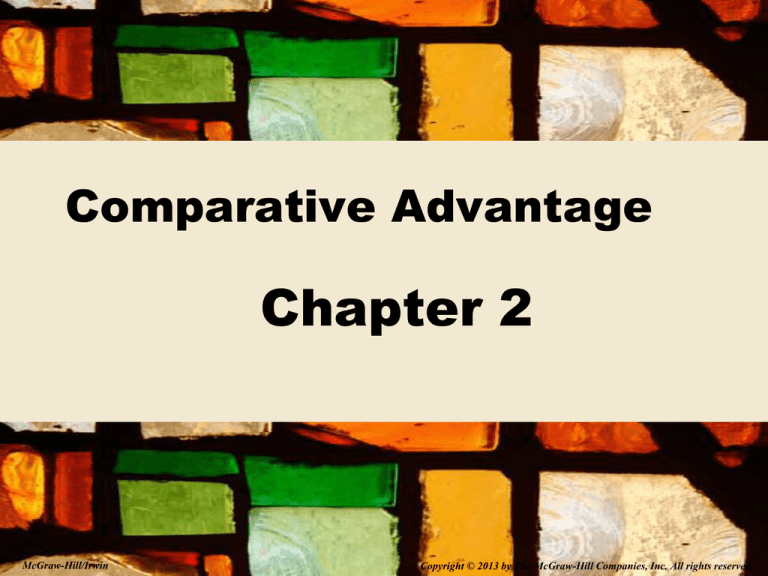
Comparative Advantage
Chapter 2
McGraw-Hill/Irwin
Copyright © 2013 by The McGraw-Hill Companies, Inc. All rights reserved.
Learning Objectives
1. Explain and apply the Principle of Comparative
Advantage
2. Explain and apply the Principle of Increasing
Opportunity Cost (also called the Low-HangingFruit Principle)
3. Identify factors that shift the menu of production
possibilities
4. Explain and apply the role of comparative
advantage in international trade and describe
why some jobs are more vulnerable to
outsourcing than others
2-2
Exchange and Opportunity Cost
• Joe Jamail, a highly successful trial attorney,
employs another attorney to write his will
– Writing your own will
– Opportunity cost of 2 hours
– Hiring someone to spend 4 hours
on your will
2 hours
$10,000
$3,200
• Do It Yourself only when
Opportunity cost < hired cost
2-3
Exchange and Opportunity Cost
• A person has an absolute advantage 絕對利
益 at a particular task if he or she can perform
the task in fewer hours than the other person
– Ex. By studying 2 more hours Paul can earn
extra 10 points in an English test while John can
earn 7 extra points.
• A person has a comparative advantage 比較利益 at
a particular task if his or her opportunity cost of
performing the task is lower than the other person’s
opportunity cost
– Ex. By studying English for 2 more hours Paul
can earn extra 10 points in an English test but
loses 8 points in math while John can earn 10
extra points in English but loses 2 in math.
2-4
The Principle of Comparative
Advantage
The Principle of Comparative Advantage
Everyone does best when each person (or each country)
concentrates on the activities for which his or her
opportunity cost is the lowest.
2-5
The Principle of Comparative
Advantage
• Two parties have different opportunity costs for
two activities
– Concentrate on the activities for which you have the
lowest opportunity cost
• Total value of output increases with
specialization and trade
2-6
Comparative Advantage
Example
Production Times
Beth
Paula
Web Update
Bike Repair
20 minutes
30 minutes
10 minutes
30 minutes
• Paula and Beth can each update web pages and
repair bikes
• Beth has an absolute advantage in both
– Comparative advantage drives specialization
2-7
Comparative Advantage
Example
Production
Times
Beth
Paula
Opportunity
Cost
Beth
Paula
Web Update
Bike Repair
20 minutes
30 minutes
10 minutes
30 minutes
Web Update
Bike Repair
2 repairs
1 repair
0.5 update
1 update
2-8
Comparative Advantage
Example
Production
Times
Beth
Paula
Hourly Output
Beth
Paula
Web Update
Bike Repair
20 minutes
30 minutes
10 minutes
30 minutes
Web Update
3 updates
2 updates
Bike Repair
6 repairs
2 repairs
2-9
Comparative Advantage Example
Hourly Output
Beth
Paula
Web Update
3 updates
2 updates
Bike Repair
6 repairs
2 repairs
• 16 web updates are ordered
– Each work 8 hours/day
– Suppose Beth spends half her time at each
activity: 12 updates and 24 repairs
– Suppose Paula produces 4 updates and 12
repairs
– Total output 16 updates and 36 repairs
2-10
Comparative Advantage Example
• Suppose Beth spend one more hour on
repair and one less hour on updates and
Paula spend 1.5 more hour on updates and
1.5 less hour on repair.
Beth
Web Update
-3 updates
Bike Repair
+6 repairs
Paula
+3 updates
-3 repairs
The number of updates remains the same
but the number of repair increases by 3.
2-11
Comparative Advantage Example
Hourly Output
Beth
Paula
Web Update
3 updates
2 updates
Bike Repair
6 repairs
2 repairs
• Paula’s specialization in updates produce
16 updates and Beth’s specialization in repair
produces 48 repairs.
• Specialization produces 12 more repairs for
the same inputs!
2-12
Another Example
Hourly Output
Pat
Barb
Web Update
2 updates
3 updates
Bike Repair
1 repair
3 repairs
• This table shows output per hour
– Apply the Principle of Comparative Advantage
• Look at opportunity cost per unit
• Pat repairs bikes and Barb updates web
pages
Opportunity
Cost
Pat
Barb
Web Update
Bike Repair
½ repair
1 repair
2 updates
1 update
2-13
Where Have All the 0.400 Hitters
Gone
• None since 1941
– Not a decline in athletic ability
• Specialization keeps averages lower
– Pitching and fielding skills have improved
• Pitchers specialize in starters, middle relievers,
and closers; right- or left-handed
batters; strike outs
• Fielders play one position
• Specialized coaches
• Detailed analysis of hitters'
weaknesses
2-14
Sources of Comparative
Advantage
• Individual level
– Education, experience, training
• Country level
– Natural resources
– Languages
– Institutions
• Value placed on craftsmanship
• Support for entrepreneurship
2-15
Production Possibilities Curve
• A production possibilities curve 生產可能線
illustrates the combinations of two goods that
can be produced with given resources
• Definitions:
24 A
Unattainable
• Inefficient point
• Efficient point
• Scarcity Principle
– Give up one good to get
another
Combination
Coffee (lb/day)
– Unattainable point
– Attainable point
16
8
B
Inefficient
Combination
C
D
4
8
12
Nuts (lb/day)
2-16
Susan's Production Possibilities
• Two goods: coffee and nuts
– Work 6 hours per day
• 1 hour of labor
– Graph shows options
• Negative slope
Coffee (lb/day)
= 4 pounds of coffee OR
= 2 pounds of nuts
24
16
8
A
B
C
D
4
8
12
Nuts (lb/day)
2-17
Susan's Opportunity Cost
From A to B
• Marginal cost: – 8 coffee
• Marginal benefit: 4 nuts
From D to B
• Marginal cost: – 8 nut
• Marginal benefit: 16
coffee
Loss in nuts
Gain in coffee
• Opportunity cost of 1 coffee
is ½ nut
24
Coffee (lb/day)
Loss in coffee
Gain in nuts
• Opportunity cost of 1 nut is
2 coffee
A
B
16
C
8
4
8
D
12
Nuts (lb/day)
2-18
Tom's Production Possibilities
– Work 6 hours per day
• Productivity determines the slope of the PPC
• From A to B
– Marginal cost: – 4 coffee
– Marginal benefit: 8 nuts
• Tom's opportunity cost of
1 coffee is 2 nuts
• His opportunity cost of
1 nut is ½ coffee
12
Coffee (lb/day)
– 1 hour of labor
= 4 pounds of nuts OR
= 2 pounds of coffee
A
B
8
C
4
D
8
16
24
Nuts (lb/day)
2-19
Tom, Meet Susan
24
Coffee (lb/day)
• PPCs show
comparative advantage
• Sue's curve is steeper,
better for coffee
• Tom's curve is flatter,
better for nuts
• Comparative advantage
is a comparison
• To get 1 coffee
• Sue gives up ½ nuts
• Tom gives up 2 nuts
Susan’s PPC
12
Tom’s PPC
12
Nuts (lb/day)
24
2-20
Gains from Specialization and
Trade
• Without trade, each person can
consume along his production
possibilities curve
– What you produce determines what you
consume
• With trade, each person's consumption
can be greater than production
– Produce according to comparative
advantage
– Trade to get what you want
2-21
Gains from Specialization and
Trade
Coffee (lb/day)
24
Susan and Tom
exchange
12 nuts, 12 coffee
12
8
8 12
Nuts (lb/day)
24
• Assume preferred diet
is half nuts, half coffee
• No trade: 8 pounds of
coffee and 8 pounds
of nuts for each
• Specialization gives
each person 12
pounds of each good
2-22
Gains from Specialization and
Trade
• Suppose for Susan 5 coffee or 1 nut per hour
and for Tom 1 coffee or 5 nuts per hour
– Sue's opportunity cost of one pound of nuts
increases to 5 coffee
– Tom's opportunity cost of one pound of coffee
increases to 5 nuts
2-23
Gains from Specialization and
Trade
Sue's PPC
Coffee (lb/day)
30
With trade
12
6
Tom's PPC
6
No trade
12
• Benefits increase when
differences in opportunity
cost increase
• No trade: 5 nuts and 5
coffee each
• With trade: 15 nuts and
15 coffee each
30
Nuts (lb/day)
2-24
Production Possibilities for an
Economy
Coffee (1000s of lb/day)
• Two goods: coffee and
nuts
• Multiple people
• Different opportunity
costs
100
95
90
A
• Intercepts show maximum
production of one good
• Some resources better at
coffee, some better at
nuts
B
C
D
E
20
15
20
30
Nuts (1000s of lb/day)
75
80
77
2-25
The Principle of Increasing
Opportunity Cost
• Maximum coffee: 100,000 lb / day
Coffee (1000s of lb/day)
– Give up 5,000 pounds coffee, get 20,000 pounds of nuts
– Give up another 5,000 pounds of coffee, get 10,000 additional
pounds of nuts
100
95
90
A
B
C
D
E
20
15
20
30
Nuts (1000s of lb/day)
75
80
77
2-26
Start with resources
with lowest
opportunity cost
Then move to next
lowest opportunity
cost
And still higher
opportunity cost
Decreasing productivity
The Principle of Increasing
Opportunity Cost
2-27
The Dynamic Economy
• A PPC represents current choices
– Changes in choices occur over time due to
• More resources
– Investment in capital
– Population growth
• Improvements in technology and knowledge
– More specialization, experiences through learning
2-28
Shifts in PPC
Neutral Technical
Change
Coffee
Technical Change
in Coffee
Coffee
Nuts
Nuts
Coffee
Technical Change
in Nuts
Nuts
2-29
Some Countries Resist
Specialization
• Specialization is easier when
– Population density passes a threshold
– Markets are connected
• Transportation for goods
• Electronic communications
– Legal framework supports business
2-30
Too Much Specialization?
• Imagine this:
– Tighten the nuts on two bolts day by day
• Specialization needs not entail rigidly
segmented repetitive work
2-31
Comparative Advantage and
International Trade
• Principle of Comparative Advantage and gains
from trade apply worldwide
– Potentially large gains from trading with different
and distant countries
• Trade can be controversial
– Trade benefits society broadly
– Costs are concentrated
• Some industries suffer
• People lose their jobs
2-32
Outsourcing
• Service work performed overseas by low wage
workers has been termed outsourcing
– Medical transcription
▪ Medical tourism
– Customer call centers
• The outsourcing of services to low-wage
foreign countries is analogous to the
importation of goods manufactured by lowwage foreign workers
2-33
Outsourcing
• Limits to outsourcing
– Quality control
– Physical presence (haircuts)
– Complex communications
• Greatest security for workers is the ability to
adapt quickly to changing circumstances
2-34
Comparative Advantage
Comparative
Advantage
Increasing
Opportunity
Cost
Production
Possibilities
Curve
Individual
Specialization
and Gains
from Trade
Outsourcing
Shift
PPC
Economy
2-35


![저기요[jeo-gi-yo] - WordPress.com](http://s2.studylib.net/store/data/005572742_1-676dcc06fe6d6aaa8f3ba5da35df9fe7-300x300.png)




